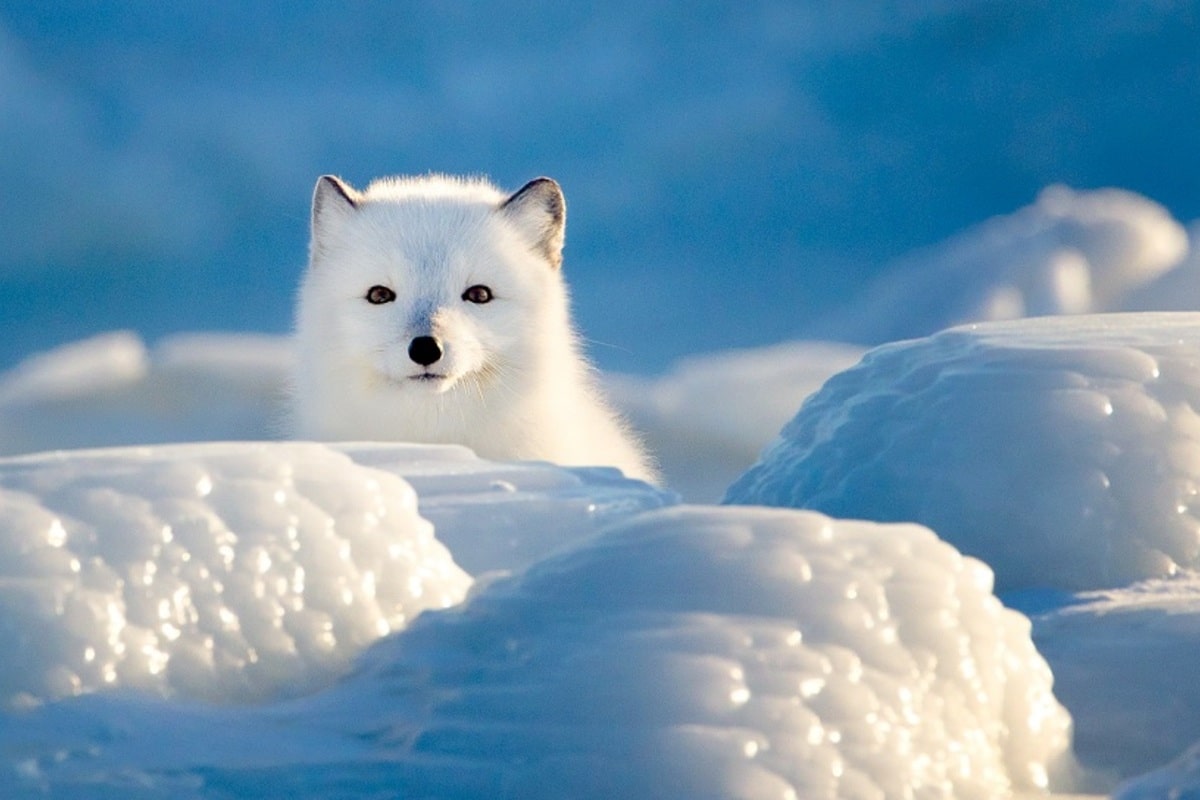Arctic foxes are remarkable creatures perfectly adapted to the harsh climate of the far north. These small predators from the canine family can survive in conditions that would be deadly for most animals. Their snow-white fur in winter and gray-brown coat in summer make them true masters of camouflage. Interesting facts about Arctic foxes help us understand how they thrive in the Arctic and what role they play in nature. You might not know that they can travel thousands of kilometers and have a significant impact on the Arctic ecosystem.
- Arctic foxes inhabit tundra regions, the coasts of the Arctic Ocean, and various northern islands. They can survive where temperatures drop below minus fifty degrees Celsius thanks to their dense fur and insulating fat layer.
- Their winter fur has a special structure that traps air, providing excellent thermal insulation. Even their paws and noses are covered with fur, preventing frostbite when walking across snow and ice.
- In summer, Arctic foxes shed their thick coats and turn grayish-brown, blending perfectly with rocks and mosses. This seasonal color change helps them hunt and stay hidden from predators.
- They have small, rounded ears that reduce heat loss. This adaptation helps them conserve body heat during strong winds and blizzards.
- Arctic foxes have an exceptional sense of hearing that allows them to detect even the slightest movement of a rodent beneath the snow. They can pinpoint the exact location of their prey and leap to break through the snow to catch it.
- Despite living in extreme conditions, Arctic foxes have a varied diet. They feed on lemmings, birds, fish, eggs, berries, and even leftovers from polar bear kills.
- When food is scarce, Arctic foxes can travel hundreds or even thousands of kilometers in search of sustenance. Some have been recorded covering over three thousand kilometers across the ice of Greenland and Canada.
- They are skilled food hoarders, storing surplus prey in the snow or under rocks. These caches help them survive during harsh weather or unsuccessful hunts.
- Unlike many mammals, Arctic foxes do not hibernate and remain active all year long. Even in the coldest winter months, they continue to hunt and explore.
- Arctic foxes often form lifelong pairs. The male and female work together to raise their young, share food, and maintain their den.
- Their dens can be extensive, with multiple entrances and tunnels. These underground structures protect the family from predators and freezing temperatures.
- A litter usually consists of five to ten pups, though some may have up to fifteen. Such large litters help the species survive in the challenging Arctic environment.
- The pups are born blind and helpless but start venturing outside the den after about three weeks. Within a few months, they become independent and learn to hunt on their own.
- Arctic foxes have an excellent sense of direction, allowing them to find their way home even after long migrations. They remember the locations of their food caches and return to them months later.
- The appearance of Arctic foxes varies across regions. For example, Greenland foxes are larger than Siberian ones, while Canadian foxes have thicker fur.
- Their natural enemies include wolves, owls, polar bears, and sometimes larger foxes. However, the biggest threat to their population comes from humans.
- During the twentieth century, Arctic foxes were heavily hunted for their valuable fur. Today, hunting them is banned in many countries, and the species is under protection.
- They can endure long periods of hunger by slowing down their metabolism. This adaptation allows them to survive without food for several days or even weeks.
- Arctic foxes are also strong swimmers and are not afraid of icy water. Their thick fur and fat layer help them cross frozen rivers and stretches of sea ice with ease.
- In some Arctic regions, foxes live close to human settlements and scavenge near waste sites or hunting camps. When they do not feel threatened, they can quickly become accustomed to human presence.
- Scientists study Arctic fox migrations using satellite tracking devices. Data show that these animals can travel over sixty kilometers per day across the ice.
- In captivity, Arctic foxes live longer than in the wild. While their lifespan in nature is about five years, those cared for by humans can live up to ten years.
- They play an essential role in nature by controlling rodent populations and maintaining ecological balance in the tundra. Without them, the Arctic ecosystem would change dramatically.
- In the mythology of northern peoples, Arctic foxes are often portrayed as clever and wise spirits. They symbolize endurance, adaptability, and intelligence.
- In modern culture, Arctic foxes have become popular thanks to films and documentaries showing their life among the ice. They fascinate people with their beauty, resilience, and ability to survive in extreme conditions.
Arctic foxes are true masters of survival, proving that nature can create incredibly adaptable and intelligent beings. Their ability to withstand severe cold, care for their families, and travel vast distances makes them unique among animals. Interesting facts about Arctic foxes remind us how extraordinary and diverse life in nature can be. Perhaps these remarkable creatures teach us persistence, courage, and harmony with the natural world.





